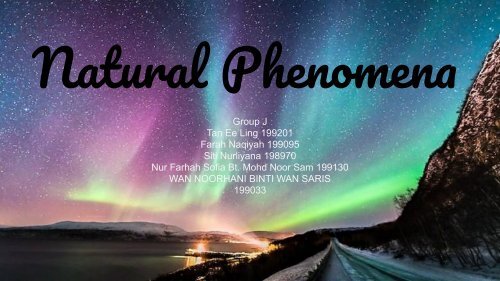NATURAL PHENOMENA
Create successful ePaper yourself
Turn your PDF publications into a flip-book with our unique Google optimized e-Paper software.
Natural Phenomena<br />
Group J<br />
Tan Ee Ling 199201<br />
Farah Naqiyah 199095<br />
Siti Nurliyana 198970<br />
Nur Farhah Sofia Bt. Mohd Noor Sam 199130<br />
WAN NOORHANI BINTI WAN SARIS<br />
199033
SNOW<br />
Snow is formed when ice<br />
crystals collide and stick<br />
together<br />
As the particles increase in size and<br />
weight, even bigger ice crystals called<br />
snowflakes are formed<br />
It is related to the entire life cycle of water<br />
that is from liquid state through solid and<br />
finally back to vapor<br />
Air temperature doesn’t have to be below<br />
freezing (0°C) for it to snow<br />
The heaviest snow fall tends to occur when the<br />
temperature of the air is between 0-2°C. If the<br />
temperature is > 2°C then the snowflake will begin<br />
to melt and fall as sleet instead – warmer still, and<br />
the precipitation turns into rain
Type of tornado<br />
Supercell<br />
A supercell is large long-lived<br />
thunderstorm. It can produce some<br />
of the largest and most violent<br />
tornadoes.<br />
Waterspout<br />
A waterspout forms over water.<br />
They usually dissipate when they hit<br />
land.<br />
Landspout<br />
A landspout is similar to a<br />
waterspout, but on land. It is weak<br />
and is not associated with a vortex of<br />
air from a thunderstorm.<br />
Gustnado<br />
A small tornado formed at a weather<br />
front by gusts of wind.<br />
Multiple vortex<br />
A tornado with more than one<br />
spinning tube of air.<br />
TORNADO<br />
Characteristics<br />
- Violent windstorm<br />
- Twisting<br />
- Funnel shaped cloud<br />
- Cool air overrides a<br />
layer of warm air<br />
- Derived from spanish<br />
word “tomar” = to turn<br />
How it happen<br />
A large thunderstorm occurs in a<br />
cumulonimbus cloud<br />
A change in wind direction and wind<br />
speed at high altitudes causes the air to<br />
swirl horizontally<br />
Rising air from the ground pushes up on<br />
the swirling air and tips it over<br />
The funnel of swirling air begins to suck<br />
up more warm air from the ground<br />
The funnel grows longer and stretches<br />
toward the ground<br />
When the funnel touches the ground it<br />
becomes a tornado
ainbow<br />
●<br />
●<br />
●<br />
●<br />
●<br />
a multicolored arc in the sky which appears when sunlight hits water droplets<br />
can also be full circles<br />
caused by reflection, refraction and dispersion of light<br />
comes from an optical illusion caused by any water droplets viewed from a certain angle relative to<br />
a light source<br />
not located at a specific distance from the observer<br />
When a ray of sunlight strikes a<br />
water droplet, most of the light<br />
bounces off its rear wall and is<br />
reflected back<br />
As soon as a ray of sunlight enters<br />
a water droplet, it is split up into its<br />
components, causing its colors to<br />
fan out and become visible as a<br />
spectrum of colors.<br />
Each color is refracted in a<br />
marginally different direction,<br />
creating the impression of a<br />
fan of colors
A lunar eclipse occurs<br />
when the Moon passes<br />
directly behind Earth<br />
and into its shadow<br />
LUNAR<br />
ECLIPSE<br />
EARTH, MOON AND SUN MUST BE IN STRAIGHT LINE<br />
SOLAR<br />
ECLIPSE<br />
A solar eclipse occurs when an<br />
observer (on Earth) passes<br />
through the shadow cast by the<br />
Moon which fully or partially<br />
blocks ("occults") the Sun


